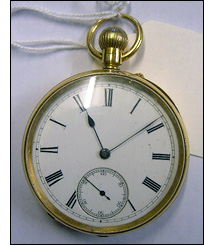Pocket Watches
Posted by Gill Jones on 21/07/2013
 I love pocket watches and have a certain affection for them, they are the gentleman’s watch and give off a certain elegant charm to its wearer. Sherlock Holmes used his Hunter case watch to solve many a case and perhaps this is where my affection for the pocket watch comes from, the eccentric detective sleuth solving crimes and making discoveries with his pocket watch close to his chest.
I love pocket watches and have a certain affection for them, they are the gentleman’s watch and give off a certain elegant charm to its wearer. Sherlock Holmes used his Hunter case watch to solve many a case and perhaps this is where my affection for the pocket watch comes from, the eccentric detective sleuth solving crimes and making discoveries with his pocket watch close to his chest.
I never realised how many different types of pocket watches there are and with such a fascinating history behind them. Pocket watches were used mainly by the upper classes and were around as early as the 15th century; they would have been made of steel and hung around the neck. They would probably have been quite heavy to carry in this way and more often than not were inaccurate in their timing. In the 16th century they became more popular with the upper classes, the German watchmaker Peter Henlein would make inroads with his pocket watch designs bringing the spring loaded mechanism to Europe in the 1520s. Italy and England would follow suit in pocket watch design, eventually graduating to other metals such as brass, gold and silver.
In the 17th and 18th centuries minute hands were introduced with delicate inner spring workings and more wheels added to lessen the amount of times the watches needed winding up. Jewels such as rubies were used for the bearings inside and oil was used to prevent watches internal mechanisms from seizing up.
During the Industrial revolution pocket watches were gradually used by the middle and lower classes. Railroad workers were given special grade pocket watches, as it was essential to their job that watches were accurate and hard wearing. Eventually the railroad watch would become so popular it would go on to become a collector’s piece.
Wrist watches were introduced by World War 1, and the development of Quartz put pocket watches in the shade. Today pocket watches are popular with collectors and they are well worth the investment not just for their financial value, but for their beauty and historical significance.
If you’re buying a pocket watch there are so many to choose from, there’s the classic open faced pocket watch with no cover, prone to damage and not particularly popular in its time. The Hunter watch on the other hand came with a lid, which protected the watch face. The only downside with this was that it became tiresome constantly taking the watch out to open the lid, which is why the half Hunter watch was created. This gave the wearer the advantage of being able to see the time through a hole without having to open up a lid. This was followed by the double Hunter pocket watch with a lid on both sides making it possible to see the mechanical bits at the back. The double half Hunter had everything the double Hunter had, but also came with a window to view the dial without having to open a full lid but offering the same protection.
When you’re looking for a pocket watch it’s important to make sure you’ve done your homework first and know exactly what you’re looking for, the same should apply to the seller; look out for a dealer that knows his pocket watches. He/She should know the history of the watch including any accidental damage over the years. Also important to keep in mind is the maker of the watch itself, as this will determine its value and popularity.
There are some particularly beautiful watches on www.antiques.co.uk including the classic pocket watch without lid, dating back to the 19th century in 18 carat gold. Another from the same period is a solid silver pocket watch with Swiss cylinder movements and key for winding, it has roman numerals and a porcelain dial. Although pocket watches would lose some of their popularity by the First World War, there’s a particularly beautiful military watch from the Second World War, its inner workings are exquisite with a plain back and face and Arabic numerals. Although plainer and less ornate than earlier watches there is something beautiful in its stark appearance, something haunting.
Whichever type of pocket watch you admire the most, you have to admit there is something quite beautiful about them and they’re unlikely to decrease in popularity anytime soon. With all the technological innovations with watch making it’s good to go back to a time when a watch needed winding up and in your hand you held a complex piece of machinery, put together by craftsmen with pin point accuracy.





